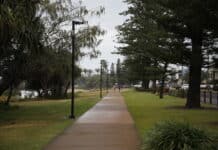VIDEO: Esty Yanco
Cameras with night vision have captured the antics native wildlife in Barolin Nature Reserve get up to when no one is watching.
The wildlife cameras with night vision were positioned throughout the Barolin Nature Reserve as part of a collaborative project between Council and students of Bargara State School.
The project was spearheaded by local conservation biologist Esty Yanco in collaboration with the Reef Guardian group.
The resulting (and adorable) footage reveals the range of wildlife found in our natural areas just a short distance away from urban areas.
Bundaberg Regional Council Natural Areas Officer Sally Obst said the footage revealed some of the more common species found in the reserve including echidna, wallabies, kangaroos and possums.
“This was a wonderful project to be a part of because it helped to show our community the variety of animals found in our nature reserves,” Sally said.
“Many Australian animals are nocturnal, having adapted to our hot and dry conditions, so it’s sometimes easy to forget they are there, even if you visit these areas on a regular basis.
“This just goes to show how important our natural areas are as they provide homes and places for animals to feed and breed.”
Wildlife behaviour in the Barolin Nature Reserve
Sally shared her analysis of the footage:
Short-beaked echidna (Tachyglossus aculeatus)
- They have spines like a porcupine, a pouch like a kangaroo and lay eggs like a reptile
- It’s likely that the echidna in the footage was searching for ants and termites to eat – they also eat insect larvae and worms
- Once they find an ant or termite nest they will open them up with their claws and poke their saliva covered tongues into the nests and flick insects back into their mouths
Swamp Wallabies (Wallabia biocolor)
- In the footage the swamp wallaby is foraging for food – they eat coarse leaved plants like grasses and bracken fern
- You can see from its upright ears in the footage that they are constantly on alert for any possible threat such as predators (foxes/cats/snakes) – to help them on the lookout for danger they have a 324 degree field of vision
- You can also see the wallaby grooming in the footage – they have short small forelimbs with five clawed fingers on their paws which they use for grooming, fighting and pulling branches to them.
Eastern Grey Kangaroo (Macropus giganteus)
- In the footage the mum is searching for food and the joey is eating what it can reach from the pouch which is likely to be grass
- During the day the mum and joey will be resting in the shade – like wallabies they are crepuscular, being active at dawn and dusk
- The female will carry the joey in her pouch for around 9 months, once it leaves the pouch it will still stay near mum and suckle from her, finally becoming independent around 18 months of age
- You can see in the footage how she uses her hind legs and ‘fifth leg’ i.e. her tail for balance, kangaroos will always move both of their hind legs together
- Swamp wallabies and eastern grey kangaroos are common in the reserve and people may see them resting during the day.
- Other news: Greenfleet leads Barolin tree-planting project
- Linda takes on mum duties for orphaned baby possums







